What Were Some Byzantine Contributions to Art and Learning?
Byzantine fine art (fourth - 15th century CE) is generally characterised past a move away from the naturalism of the Classical tradition towards the more abstract and universal, there is a definite preference for 2-dimensional representations, and those artworks which comprise a religious bulletin predominate. Still, past the 12th century CE Byzantine art has go much more expressive and imaginative, and although many subjects are endlessly recycled, there are differences in details throughout the menses. Whilst it is truthful that the vast majority of surviving artworks are religious in subject field, this may be a result of selection in subsequent centuries as in that location are arable references to secular art in Byzantine sources and pagan subjects with classical iconography continued to be produced well into the 10th century CE and beyond. Using brilliant stones, gold mosaics, lively wall paintings, intricately carved ivory, and precious metals in full general, Byzantine artists beautified everything from buildings to books, and their greatest and almost lasting legacy is undoubtedly the icons which continue to decorate Christian churches effectually the globe.
Influences
As Byzantium was the eastern co-operative of the Roman Empire in its earliest stage, information technology is not surprising that a strong Roman, or more precisely, Classical influence predominates Byzantine output. The Roman tradition of collecting, appreciating, and privately displaying antique art likewise connected amongst the wealthier classes of Byzantium. Byzantine art is at once both unchanging and evolutionary, themes such as the Classical traditions and conventional religious scenes were reworked for century after century, but at the same time, a closer examination of individual works reveals the details of an ever-changing approach to art. As with modern cinema that regularly remakes a familiar story with the aforementioned settings and the same characters, Byzantine artists worked within the limits of the practical end office of their work to make choices on how best to nowadays a subject, what to add and omit from those new influences which came along, and, past the end of the period, to personalize their work as never earlier.
In the Byzantine Empire, there was little or no distinction between artist & craftsperson, both created beautiful objects for a specific purpose.
Information technology is perhaps important to remember that the Byzantine Empire was much more Greek than Roman in many aspects and Hellenistic art connected to be influential, especially the idea of naturalism. At the same fourth dimension, the geographical extent of the empire likewise had its implications for art. In Alexandria the more rigid (and for some, less elegant) Coptic style took off from the sixth century CE, replacing the predominant Hellenistic mode. Half-tone colours were avoided and brighter ones were favoured while figures are squatter and less realistic. Another expanse of creative influence was Antioch where the 'orientalizing' manner was adopted, that is the assimilation of motifs from Persian and central Asian art such every bit ribbons, the Tree of Life, ram's heads, and double-winged creatures, as well as the full frontal portraits which announced in the art of Syrian arab republic. In plough, the fine art of these great cities would influence that produced in Constantinople, which became the focal point of an art industry that spread its works, methods, and ideas throughout the Empire.
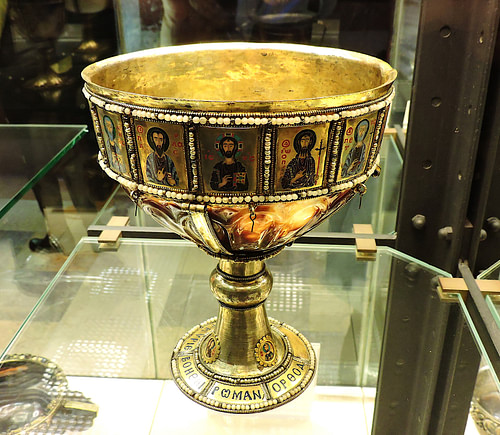
Byzantine Beaker
The Byzantine Empire was continuously expanding and shrinking over the centuries, and this geography influenced art as new ideas became more readily accessible over time. Ideas and art objects were continuously spread between cultures through the medium of majestic gifts to fellow rulers, diplomatic embassies, religious missions, and souvenir-buying wealthy travellers, not to mention the motion of artists themselves. From the early 13th century CE, for instance, Byzantium was influenced by much greater contact with western Europe, simply as it had been when the Byzantines were more than present in Italy during the ninth century CE. The influence went in the other direction, too, of class, so that Byzantine creative ideas spread, notably outwards from such outposts as Sicily and Crete from where Byzantine iconography would go along to influence Italian Renaissance fine art. So, too, in the north-east, Byzantine art influenced such places equally Armenia, Georgia, and Russia. Finally, Byzantine art is still very much live every bit a stiff tradition inside Orthodox art.
Artists
In the Byzantine Empire, at that place was little or no distinction betwixt creative person and craftsperson, both created beautiful objects for a specific purpose, whether it be a box to keep a precious belonging or an icon to stir feelings of piety and reverence. Some job titles we know are zographos and historiographos (painter), maistor (main) and ktistes (creator). In addition, many artists, notably those who created illustrated manuscripts, were priests or monks. In that location is no evidence that artists were not women, although it is likely they specialised in textiles and printed silks. Sculptors, ivory workers, and enamelists were specialists who had acquired years of training, only in other art forms, it was common for the same artist to produce manuscripts, icons, mosaics, and wall paintings.
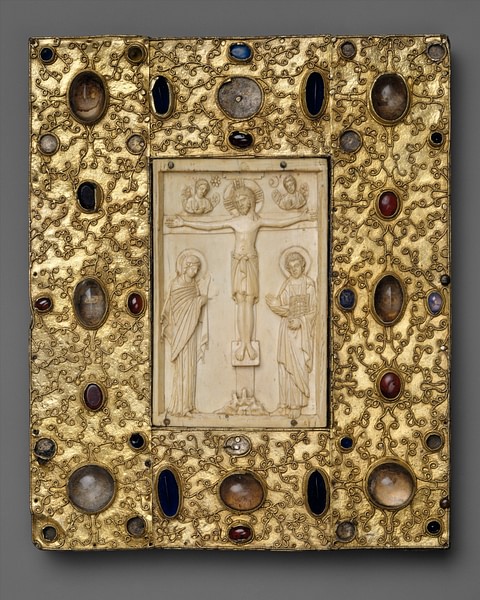
Byzantine Book Embrace with Icon
It was rare for an creative person to sign their work prior to the 13th century CE, and this may reflect a lack of social status for the artist, or that works were created by teams of artists, or that such personalization of the artwork was considered to detract from its purpose, especially in religious art. Artists were supported by patrons who commissioned their piece of work, notably the emperors and monasteries but besides many private individuals, including women, especially widows.
Frescos & Paintings
Byzantine Christian fine art had the triple purpose of beautifying a edifice, instructing the illiterate on matters vital for the welfare of their soul, and encouraging the true-blue that they were on the correct path to conservancy. For this reason, the interiors of Byzantine churches were covered with paintings and mosaics. The large Christian basilica building, with its high ceilings and long side walls, provided an ideal medium to send visual letters to the congregation, just fifty-fifty the most humble shrines were frequently decorated with an abundance of frescoes. The subjects were necessarily limited - those cardinal events and figures of the Bible - and fifty-fifty their positioning became conventional. A depiction of Jesus Christ unremarkably occupied the cardinal dome, the butt of the dome had the prophets, the evangelists appear on the joins between vault and dome, in the sanctuary is the Virgin and child, and the walls take scenes from the New Testament and the lives of the saints.
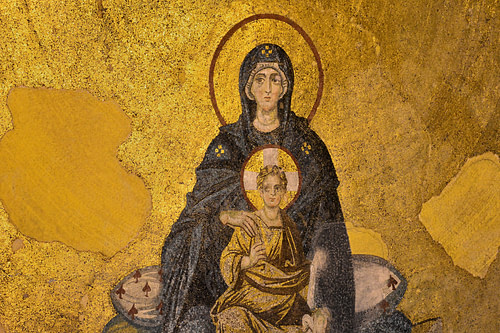
The Virgin and Child Mosaic, Hagia Sophia
Too walls and domes, small-scale painted wooden panels were another popular medium, especially in the late-Empire period. Literary sources describe small portable portrait paintings which were commissioned by a broad range of people from bishops to actresses. Paintings for manuscripts were also a valued outlet for painting skills, and these cover both religious subjects and historical events such as coronations and famous battles.
Icons - representations of holy figures - were created for veneration past Byzantine Christians from the tertiary century CE.
Fine examples of the more than expressive and humanistic manner prevalent from the 12th century CE are the 1164 CE wall paintings in Nerezi, Macedonia. Showing scenes from the cross, they capture the despair of the protagonists. From the 13th century CE, individuals are painted with personality and in that location is more attention to detail. The Hagia Sophia in Trabzon (Trebizond) has whole galleries of such paintings, dated to c. 1260 CE, where the subjects seem to accept been inspired by existent-life models. There is also a more daring employ of color for effect. A skilful instance is the use of blues in The Transfiguration, a manuscript painting in the theological works of John VI Cantacuzenus, produced 1370-1375 CE and at present in the Bibliothèque Nationale, Paris. On a larger calibration, this combination of assuming colours and fine details is best seen in the wall paintings of the various Byzantine churches of Mistra in Greece.
Icons
Icons - representations of holy figures - were created for veneration by Byzantine Christians from the 3rd century CE. They are about oft seen in mosaics, wall paintings, and equally small artworks fabricated from wood, metal, gemstones, enamel, or ivory. The most common form was small painted wooden panels which could be carried or hung on walls. Such panels were made using the encaustic technique where coloured pigments were mixed with wax and burned into the forest as an inlay.
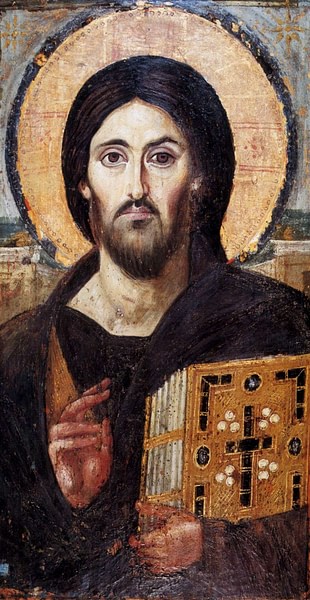
Jesus Christ Pantokrator
The subject field in icons is typically portrayed full frontal, with either the full figure shown or the caput and shoulders only. They stare directly at the viewer equally they are designed to facilitate communication with the divine. Figures often have a nimbus or halo around them to emphasise their holiness. More rarely, icons are equanimous of a narrative scene. The artistic approach to icons was remarkably stable over the centuries, but this should non perchance be surprising as their very subjects were meant to nowadays a timeless quality and instil a reverence on generation subsequently generation of worshippers - the people and fashions might change merely the message did not.
Some of the oldest surviving Byzantine icons are to exist establish in the Monastery of Saint Catherine on Mount Sinai. Dating to the 6th century CE and saved from the wave of iconoclasm which spread through the Byzantine Empire during the eighth and 9th century CE, the finest show Christ Pantokrator and the Virgin and Kid. The Pantokrator image - where Christ is in the classic full frontal pose and is property a Gospel book in his left paw and performing a blessing with his correct - was probably donated by Justinian I (r. 527-565 CE) to mark the monastery's foundation.
By the twelfth century CE, painters were producing much more intimate portraits with more expression and individuality. The icon known as the Virgin of Vladimir, now in the Tretyakov Gallery in Moscow, was painted in Constantinople c. 1125 CE and is an excellent example of this new fashion with its tender representation of the child pressing his cheek confronting his mother.

Homo Feeding Mule, Byzantine Mosaic
Mosaics
The majority of surviving wall and ceiling mosaics depict religious subjects and are to be found in many Byzantine churches. One of their characteristics is the use of gold tiles to create a shimmering background to the figures of Christ, the Virgin Mary and saints. Equally with icons and paintings, the portraiture follows certain conventions such as a total frontal view, halo, and general lack of suggested motion. The Hagia Sophia in Constantinople (Istanbul) contains the most historic examples of such mosaics while one of the near unusually striking portraits in the medium is that of Jesus Christ in the dome of Daphni in Greece. Produced around 1100 CE, it shows Christ with a rather fierce expression which is in contrast to the usual expressionless representation.
The mosaics of the Not bad Palace of Constantinople, which date to the 6th century CE, are an interesting mix of scenes from daily life (particularly hunting) with pagan gods and mythical creatures, highlighting, once again, that pagan themes were not wholly replaced by Christian ones in Byzantine art. Another secular subject for mosaic artists was emperors and their consorts, although these are often portrayed in their role as head of the Eastern Church. Some of the most celebrated mosaics are those in the church of San Vitale in Ravenna, Italia, which date to the 540s CE. Two glittering panels testify Emperor Justinian I and his consort Empress Theodora with their respective entourages.
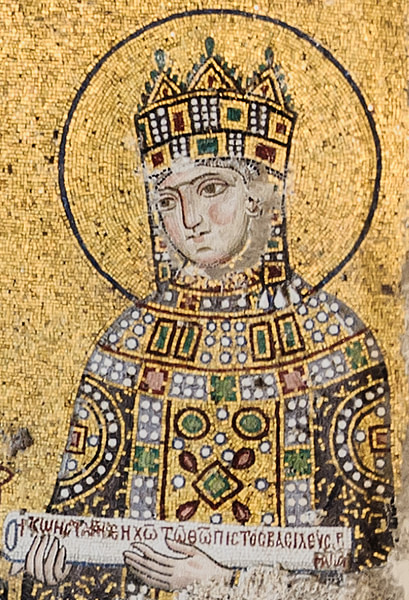
Byzantine Empress Zoe
Byzantine mosaic artists were so famous for their work that the Arab Umayyad Caliphate (661-750 CE) employed them to decorate the Dome of the Rock in Jerusalem and the Great Mosque of Damascus. Finally, but as in painting, in the 13th and 14th century CE, the subjects in mosaics go more natural, expressive and individualised. Excellent examples of this style can be seen in the mosaics of the Church building of the Saviour, Chora, Constantinople.
Sculpture
Realistic portrait sculpture was a characteristic of afterwards Roman fine art, and the trend continues in early Byzantium. The Hippodrome of Constantinople was known to take bronze and marble sculptures of emperors and pop charioteers, for example. Ivory was used for figure sculpture, too, although just a single free-standing example survives, the Virgin and Child, at present in the Victoria and Albert Museum, London. Marble and limestone sarcophagi were another outlet for the sculptor'south craft. After the 6th century CE, though, three-dimensional portraits are rare, even for emperors, and sculpture reached nowhere near the popularity it had in artifact.
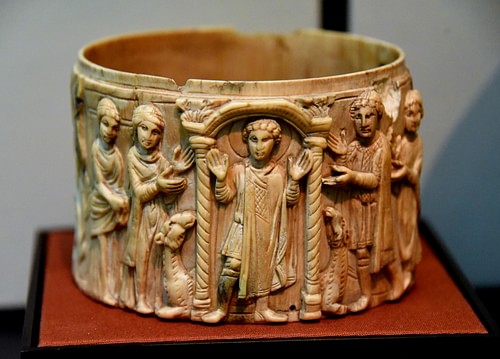
Ivory Pyxis Depicting Saint Menas
Minor Arts
Byzantine artists were accomplished metalsmiths, while enamelling was another surface area of high technical expertise. A superb example of the employ of both skills combined is the c. 1070 CE chalice in the Treasury of Saint Mark's, Venice. Made with a semi-gem trunk and gold stem, the cup is decorated with enamel plaques. Cloisonné enamels (objects with multiple metal-bordered compartments filled with vitreous enamel) were extremely popular, a technique probably acquired from Italy in the 9th century CE. Silver plates stamped with Christian images were produced in large numbers and used as a domestic dinner service. A last apply of metals is coinage, which was a medium for imperial portraiture and, from the eighth century CE, images of Jesus Christ.
Bibles were made with beautifully written text in golden and silver ink on pages dyed with Tyrian purple and beautifully illustrated. One of the best surviving examples of an illustrated manuscript is the Homilies of Saint Gregory of Nazianzus, produced 867-886 CE and now in the Bibliothèque Nationale, Paris. Books, in general, were often given exquisite covers using gold, argent, semi-precious stones, and enamels. Reliquaries - containers for holy relics - were another avenue for the decorative arts.
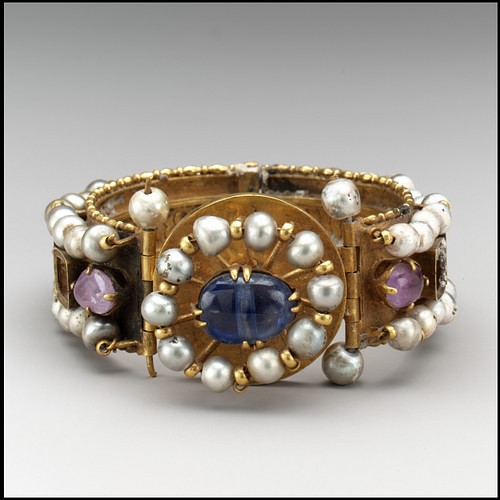
Byzantine Jeweled Bracelet
Portable objects were very often decorated with Christian images, and these include such everyday items as jewellery boxes, ivories, jewellery pieces, and pilgrim tokens. Objects made from ivory such as panels and boxes were a particular speciality of Alexandria. Panels were used to decorate almost anything merely especially furniture. Ane of the most celebrated examples is the throne of Maximian, Archbishop of Ravenna (545-553 CE), which is covered in ivory panels showing scenes from the lives of Joseph, Jesus Christ and the Evangelists. Textiles - of wool, linen, cotton, and silk - was another medium for creative expression, where designs were woven into the fabric or printed by dipping the cloth in dyes with some parts of the cloth covered in a resistor to create the blueprint.
Finally, Byzantine pottery has largely escaped public observe, but potters were accomplished in such techniques as polychrome (coloured scenes painted on a white background then given a transparent glaze) - a technique passed on to Italia in the ninth century CE. Designs were sometimes incised and given coloured glazes, every bit in the 13th-14th century CE fine plate showing ii doves, now in the Collection David Talbot Rice at the University of Edinburgh. Mutual shapes included plates, dishes, bowls, and unmarried-handled cups. Tiles were ofttimes painted with representations of holy figures and emperors, sometimes several tiles making up a composite image.
This article has been reviewed for accuracy, reliability and adherence to academic standards prior to publication.
Source: https://www.worldhistory.org/Byzantine_Art/